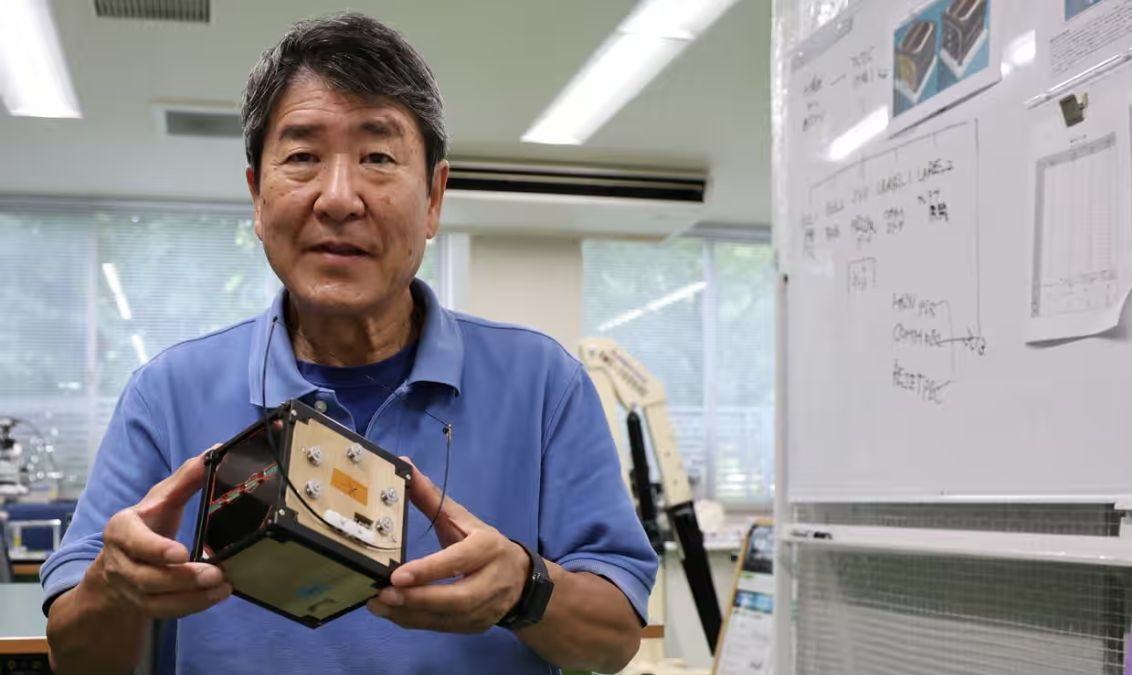LignoSat, the world’s first wooden satellite, was launched on November 5, 2024, aboard a SpaceX rocket from NASA’s Kennedy Space Center in Florida, with Japan’s Kyoto University and the Japan Aerospace Exploration Agency (JAXA) overseeing the project. Its primary mission is to test the durability of wood in the harsh environment of space, with the ultimate goal of reducing space junk.
In this article, we will learn what is LignoSat, its significance, its specifications, and how it will contribute to mitigating space debris issue.
What is LignoSat, and why is it significant?

Takao Doi, an astronaut and professor at Kyoto University, holding an engineering model of LignoSat; Image: Reuters
LignoSat, the world’s first wooden satellite, is Japan’s groundbreaking first-of-its-kind wooden satellite, Developed by a team of scientists at Kyoto University, the satellite is designed to explore the potential of using timber as an environmentally friendly alternative to metals in satellite construction.
What is LUPEX Mission? India’s 5th Lunar Polar Exploration Mission: Key Facts
What is the mission of LignoSat?
LignoSat is designed to spend six months orbiting Earth while subjected to extreme conditions including exposure to cosmic radiation, high-temperature variations, and microgravity. During this period, it will collect data on the durability and resilience of wood in space. If successful, the findings from LignoSat could lead to a new approach in satellite construction, where wood replaces traditional metals, thereby lowering the amount of waste that survives atmospheric re-entry.
Why did Japan choose wood for this satellite?
Japan selected magnolia wood for the construction of LignoSat's panels, as magnolia is known for its resilience and is widely used in traditional Japanese crafts. The wood was crafted using an ancient Japanese technique that avoids the use of screws or glue, making it both lightweight and sturdy. By choosing wood, the satellite will fully burn up upon re-entry, leaving no trace in the atmosphere—a feature that could help prevent further space debris.
Science Behind It: Why Sky Is Blue?
What challenges does LignoSat aim to address regarding space debris?
Space debris has become an increasingly urgent concern as the number of satellites and space missions rises. Traditional satellites are constructed from metal components that often survive re-entry, creating hazardous debris in Earth’s orbit. This accumulation of “space junk” poses risks to active satellites, space stations, and even astronauts. By creating a biodegradable satellite, Japan hopes to introduce a solution that could mitigate the debris issue by developing materials that fully disintegrate when they re-enter the Earth’s atmosphere.
What makes LignoSat’s design unique?
LignoSat’s wooden structure is built with lightweight magnolia wood, contributing to its small size (just 10 cm) and low weight of only 900 grams. The choice of wooden panels crafted without screws or glue is unusual for satellite design, and this assembly method ensures that the satellite remains both compact and robust. The simplicity of LignoSat’s construction is aimed at reducing the environmental footprint of satellite manufacturing and testing new, sustainable materials that could influence future spacecraft.
Science Behind It: How Do Airplanes Fly?
How will LignoSat's durability be tested in space?
Once in orbit, LignoSat will undergo a series of tests to observe how magnolia wood withstands the extreme temperature changes, cosmic radiation, and lack of atmospheric protection characteristic of space. Over its six-month mission, researchers will monitor any changes to the wood’s structure, integrity, and resilience, comparing these findings to the performance of traditional materials like metals.
Conclusion
If LignoSat proves viable, Japan may consider launching additional wooden satellites or expanding the use of timber in spacecraft construction. Kyoto University’s Human Spaceology Center and other researchers are already exploring alternative materials and design techniques to minimize the environmental impact of space missions.
Comments
All Comments (0)
Join the conversation